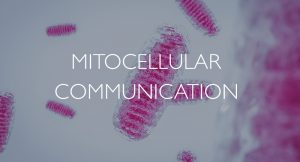 #Mitochondria are the parts of cells that turn #sugars, #fats and #proteins into forms of chemical energy that the body can use to carry on living. They are #organelles that are found in the cells of every complex #organism and produce around 90% of the chemical energy required for cells to survive. They are the only organelles to retain their own genome and the communication abilities of transcription and translating in order to harvest energy. Their complex communication network allows them to stay in tune with #cellular needs and nuclear transcriptional programs and to alleviate mitochondrial dysfunction. Swiss cytologists have published a review of recent findings on the wide array of different mechanisms that contribute to these mitocellular communication networks.
#Mitochondria are the parts of cells that turn #sugars, #fats and #proteins into forms of chemical energy that the body can use to carry on living. They are #organelles that are found in the cells of every complex #organism and produce around 90% of the chemical energy required for cells to survive. They are the only organelles to retain their own genome and the communication abilities of transcription and translating in order to harvest energy. Their complex communication network allows them to stay in tune with #cellular needs and nuclear transcriptional programs and to alleviate mitochondrial dysfunction. Swiss cytologists have published a review of recent findings on the wide array of different mechanisms that contribute to these mitocellular communication networks.
Mitochondria exchange molecules with the rest of the cell and the organism. Through the process of evolution most genes encoded in the mitochondrial genome were transferred to the nucleus, this left a few protein-coding genes in the vestigial circular mitochondrial DNA (#mtDNA) and the requirement for both mitochondria and nucleus to communicate to ensure optimal cellular function. To gain the maximum advantage of mitochondrial communication, it is key we understand the differences between adaptive and maladaptive responses to stress. Mitochondria lose function through aging, and mitocellular communication pathways break down. In order to increase both health and life span, strategies are needed to maintain and invigorate mitochondrial function.
An important indicator of the metabolic status of mitochondria is the nicotinamide adenine dinucleotide (#NAD+) with levels varying through caloric restriction or high-fat diets, decreasing through aging, and increasing during exercise or pharmacological/nutraceutical interventions. Some of the deleterious effects of decreased NAD+ levels can be stabilised by cells capable of sensing low oxygen through prolyl hydroxylase domain proteins (#PHDs). Mitochondrial dysfunction can also generate toxic by-products such as reactive oxygen species (#ROS). ROS produced by mitochondria stabilises the hypoxia-inducible factor (#HIF-1a) which is important for life-span extension. Acetyl-coenzyme A (#acetyl-CoA) is produced from various sources inside mitochondria and enters the tricarboxylic acid (#TCA) cycle to generate citrate. Citrate can either continue in the TCA cycle or exit and produce acetyl-CoA. As a result, any variations in acetyl-CoA are mitochondrial signals that can modulate broad gene expression programs.
The review has been published in Science.Mag.org and concluded that we need to consider the importance of what they call the #mitobiome, which is ten times larger than our microbiome and with multiple differences in subcellular and cellular pools of mitochondria, is far more complex. In contrast, mitochondria need to be thought of as small, “semiautonomous” entities with their own genome that can be shaped into populations able to communicate with each other, with other organelles, and even with distant tissues through a range of languages. If we can understand these languages, we will be better able to develop mitochondrial medicines able to treat diverse pathologies. Michael Ash and Garth Nicolson have previously published papers, available on our clinical education website linked below, on mitochrondia and lipids, and their multiple signalling outputs and needs, which can widen our knowledge of the subject.





